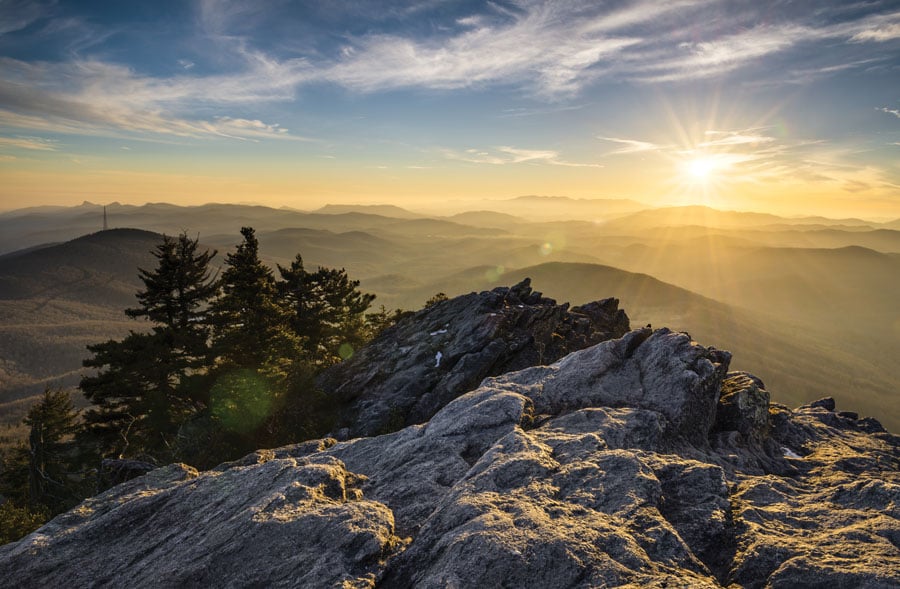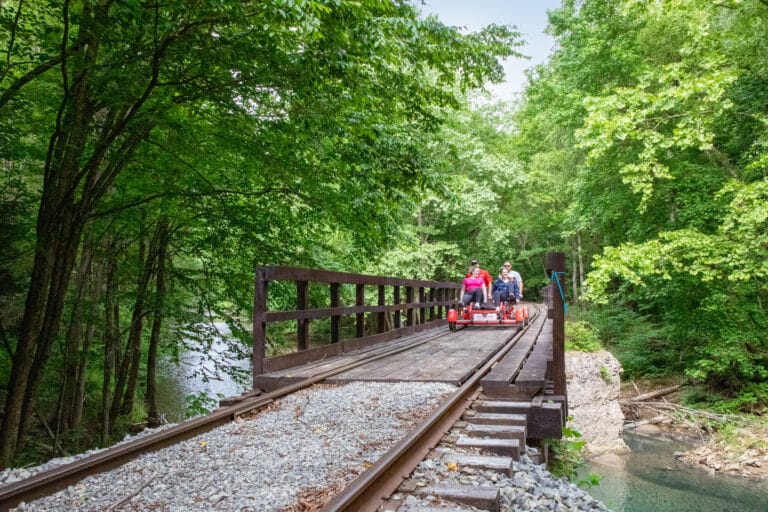“It’s all been logged.”
That’s what I was told when I asked if there were any old-growth forests left in the South. Growing up in rural Western North Carolina, I was intrigued by the tales of the huge trees that once grew in my neighborhood. The thought that not one acre of forest had been left unlogged for me to enjoy saddened me, and didn’t fit with what I saw in the woods around me. Some steep, rocky areas and property boundaries had large and seemingly old trees. The more people I asked, the more complex the answers became. When I asked knowledgeable locals and outdoorsmen about specific areas like Spring Creek Gorge, I got promising answers like “Well I know that’s never been logged in my lifetime.”
For the past three years, I have been working in conjunction with the Southern Appalachian Forest Coalition and other conservation groups to document and protect the last vestiges of the original forest cover that blanketed the Blue Ridge when European settlers first arrived. Since 1994, this project has turned up over 114,000 acres of old-growth on the six National Forests of the Southern Blue Ridge – that’s 4.5% of our local National Forests, or 1.5% of the Blue Ridge as a whole. At least 14 biologists, ecologists, foresters, botanists and citizen scientists who have worked for 12 years with little or no funding to protect these special places by giving them a voice.
The reason these ancient forests need advocates, is that occasionally, the U.S. Forest Service comes up with a project that proposes logging of old-growth. An example this year is the Globe Timber Sale in the Grandfather Ranger District of Pisgah National Forest. In such cases, conservation and recreation groups ask the Forest Service to exclude the old-growth sections from the logging proposal. The Globe Project is still being planned by the Forest Service and needs a lot of public input to keep the old-growth from being logged (see “Save the Globe” on page 24 for more details).
Environmental and recreational groups have succeeded in protecting old-growth in this manner for the past ten years. But the outcomes are not always successful. At Hoover Creek in Virginia’s George Washington National Forest, 200 acres of old-growth were logged despite the outcry of locals. After the trees had been cut it was apparent that many had been over 200 years old.
In some cases, the Forest Service does not intentionally log old-growth, but simply does not have accurate information about the millions of acres of forest it manages. With the Forest Service receiving inadequate funding each year, citizens are left to do the work of identifying and protecting old-growth forests.
Almost all of the known old-growth sites in the Blue Ridge are still with us because of one or a combination of three factors: steep slopes, early purchase date (usually before 1925), and lack of commercial viability. Usually, steep slopes and noncommercial forests go hand in hand. Soils at such sites are dry, because they drain quickly, and are often leached of nutrients. Some sites, however, have rich soils or occur on gentler slopes above gorges, waterfalls, or other impediments to logging, and these sites grow not only old, but big trees. Finally, a different class of site, including many of the smaller tracts bought from farmers or seized from them by eminent domain, have old-growth forest for historical reasons. Some farmers kept their woods as places to hunt or to graze their livestock on chestnuts. Some, like Robert “Boogerman” Palmer, were simply reclusive and refused to sell their land to timber companies.
Serendipity is the final factor that saved some old-growth forests. Joyce Kilmer Memorial Forest is an example of this. Little Santeetlah Creek was on the verge of being logged several times, but the flooding of Santeetlah Lake stopped logging and then financial catastrophe to the parent logging company forced the land to be sold. The land changed ownership many times and finally, in 1936, Joyce Kilmer Memorial Forest was created, just as equipment was being moved to the area to log it.
Some are skeptical of the emerging picture of 100,000+ acres of National Forest old-growth, and rightly so, they have been told the same stories about the history of our forests that I have. The roots of this myth originate in the perception that all old-growth forests have giant, eight-foot-diameter trees. Unfortunately, those places were logged first. What we have left is less impressive size-wise, but just as inspiring in character.
Here is the criteria generally used to classify old growth:
1) A lack of human disturbance: Old-growth forests lack logging roads, skidder trails, and cut stumps. Consider that chestnut blight could be considered a form of human disturbance, and that American chestnut was important in most of our native forests, so every forest in the Blue Ridge has had some human disturbance. Uncut chestnut debris, however, can be a reliable indicator of a lack of historical logging.
2) The presence of old trees: All the sites in the SAFC data base have canopy trees whose ages are confirmed at over 150 years of age, and some have trees confirmed at over 300 years of age; a small handful are known to have trees in the 400+ year range. All of these sites are very remote, and unsuitable for agriculture. The big logging boom in the Southern Blue Ridge was 80-100 years ago, so 150 years is a reasonable proxy for old-growth status.
3) A mixed-age canopy: When trees die of old age, or fall because of a natural disturbance like a storm, they leave canopy gaps that allow younger trees to grow, creating a mosaic of tree sizes and ages.
4) The presence of coarse woody debris: Coarse woody debris is a fancy biological term for decaying wood. Old forests usually have copious amounts of decaying wood, varying from freshly fallen, to indistinguishable from soil.
5) Snags: Snags are standing dead trees. They provide important habitat for a number of wildlife species including woodpeckers and black bears. They tend to be more common in forests where trees are allowed to die of natural causes.
6) Complex character: The most difficult to quantify and reliable characteristic of old-growth forests is their structural and biological complexity. An example of this concept is that old-growth forests tend to have more diverse biological communities than second growth forests of the same type, because there is more physical structure, like snags, to utilize.
When the Eastern national forests were purchased around 1913, those responsible for acquiring them where looking for some of the most valuable, and therefore, least logged tracts of land. William Willard Ashe, one of the people most responsible for the surveying and acquiring of Blue Ridge National Forests, stated that “the larger portion of the lands which have been acquired have had the timber cut off, or at least some of the best timber has been cut, but a number of fine stands have been secured within which there has never been the sound of the lumberman’s axe.” But over the years, the knowledge that the national forests of the Southern Blue Ridge contain significant old-growth forests was shouted down by the myth that “It’s all been logged.” Because these forests have been essentially forgotten, the sum of old-growth present before 1940 has been reduced by Forest Service timber sales. Hopefully, as the American people become more aware of this great treasure on their public lands, the remainder can be protected in perpetuity.
OLD-GROWTH HIKES IN THE BLUE RIDGE
While most of the old-growth in the Blue Ridge is far off the beaten path, there are several trails that provide access to some great forests. Of course, the most impressive old-growth in the Blue Ridge is in Smoky Mountains National Park at places like Albright Grove and Ramsay Cascades. However, the following is a guide to trails in all six National Forests of the Southern Blue Ridge that pass through magnificent old-growth forests.
HOLCOMBE FALLS TRAIL
Chattahoochee National Forest
Highlights: Waterfalls, Huge Hemlocks
Protection: Informally protected
Directions: From Clayton Georgia, go east on Warwoman Rd. from its junction with US 441. Turn left on Hale Ridge Rd and park at the intersection of Hale Ridge Rd. and Overflow Rd. Rabun Bald Quad.
Holcombe Falls Trail is one of the finest in North Georgia because of the beautiful falls on Ammons Branch and Holcombe Creek, and the old-growth acidic cove forest there. One hemlock here was measured by Jess Riddle at 144 ft. tall, making it the tallest hemlock in Georgia. See this grove soon, because if it is not treated quickly, it will succumb to the hemlock wooly adelgid (hwa).
EAST FORK TRAIL
Sumter National Forest
Highlights: Wildflowers, Old-Growth Hemlocks
Protection: Permanently protected by Ellicott Rock Wilderness.
Directions: From SC 107 near the NC line follow the directions to the Walhalla Fish Hatchery, the trail begins there. Tamassee Quad.
From the parking lot to the first hundred yards of the East Fork Trail, you will immediately enter the tallest known hemlock forest. Many of the trees here are over 3 ft in diameter and 160 ft tall. Unfortunately many of the hemlocks appear to have been killed by hwa. The remainder of the East Fork Trail is very scenic, including a nice bloom of spring wildflowers. The trail follows the north bank of the East Fork of the Chattooga, which was heavily logged. However, by looking across the creek to the steep slopes of Medlin Mountain, you can look at unlogged hemlock and hardwood forests.
FALLS BRANCH TRAIL
Cherokee National Forest
Highlights: Old-growth cove and a spectacular waterfall
Protection: Permanently protected by Citico Creek Wilderness.
Directions: From the Cherohala Skyway, park at the West Rattlesnake Rock Overlook, where the trail begins. Big Junction Quad.
Falls Branch probably has Southeast Tennessee’s most impressive old-growth forest. Both rich and acidic cove forests can be found here with trees attaining sizes up to five feet in diameter. The largest trees are off-trail, through thick tangles of rhododendron, but the trail portion is just as beautiful and ends at the spectacular Falls Branch Falls.
HICKORY BRANCH TRAIL
Nantahala National Forest
Highlights: Remote with excellent oak-hickory forest
Protection: Temporarily protected as “Large Patch Old-Growth” by Nantahala National Forest.
Directions: From Andrews, take Junaluska Rd. over Junaluska Gap. Approximately 1.4 miles past Junaluska Gap park at the pull-off on the right, and look for the unmarked beginning of the Hickory Branch Trail across the road. Topton Quad.
The lower reaches of Hickory Branch were heavily logged, but for some reason, perhaps the formation of Nantahala National Forest, there appears to have been no logging above 3680’. Counting rings on trees cut by the trail is fun and will reveal ages over 200 years. The montane-oak hickory and high elevation red oak forests here are classic. This trail can be combined with the London Bald Trail and Junaluska Trail to form a loop.
SNOOK’S NOSE TRAIL
Pisgah National Forest
Highlights: Views, rare plants, dry forest communities
Protection: Protected as part of the Jarrett Creek Roadless Area.
Directions: From Old Fort go east on Hwy 70 and turn left on Curtis Creek Rd. Trail is adjacent to the new RV campground. Old Fort Quad.
The Curtis Creek area was part of the first purchase of National Forest in the East in 1913, and has some exemplary patches of old-growth because of it. The Snook’s Nose trail is a great place to get a workout (potential 3000-foot elevation gain), see some rare plants (watch out for turkey beard and Carolina rhododendron), and see a beautiful view. Above 3200’ the trail enters a dry and non-commercial forest that was never logged. Chestnut oak, black gum, red maple, black birch, table mountain pine, and Carolina hemlock, with thickets of mountain laurel and rhododendron, compose most of the forest. For those confident with their map-and-compass skills, there is a beautiful, open forest of tulip poplar and red oak NE of Laurel Knob at 4000 feet, in an area known as the “Rompous Bowl.”
CORNELIUS CREEK-APPLE ORCHARD TRAIL LOOP
Jefferson National Forest
Highlights: Outstanding spring wildflowers, Apple Orchard Falls.
Protection: Mostly protected by the North Creek Special Area. Some old-growth is still threatened by logging.
Directions: Park at Sunset Fields overlook on the Blue Ridge Parkway, between Peaks of Otter and Thunder Ridge. Walk down Rt. 812 until you reach the AT. Take the A.T. to the left (northbound) until you reach the Cornelius Creek trail. Follow the Cornelius Creek trail to the bottom of the mountain & Rt. 59 and a parking area. This is also a trailhead for the Apple Orchard Falls Trail. Follow the Apple Orchard Falls Trail to the top of the ridge and the Sunset Fields overlook. Arnold Valley Quad.
This hike passes through part of the North Creek Special Area originally protected for songbirds and other forest interior species, and enlarged in the latest Jefferson national Forest Plan Revision. A locomotive wrecked in Cornelius Creek in 1910 (removed for scrap in 1940), bankrupting a timber company, and saving portions of the North Creek watershed from logging. The area between the North Creek Special Area and the Thunder Ridge Wilderness Area (just to the north of Apple Orchard Falls) is open to commercial logging. The Parkers Gap Timber Sale was approved on steep slopes in this area. To view the site of this timber sale, drive down Rt. 812 to Rt. 765 and drive down Rt. 3034; logging will occur down slope of the road. A portion of old growth previously identified in the Draft Environmental Impact Statement for the Jefferson National Forest Plan is located in one of the cutting units. The Parkers Gap Project may begin later in 2006 or early 2007.
GARDEN MOUNTAIN-APPALACHIAN TRAIL
Jefferson National Forest
Highlights: Remote hiking experience, interesting rocky areas throughout; examples of 400 million year old ancient worm (Arthropycus) burrows or feeding trails can be seen in some of the rocks; much of the water flowing from this mountain provides habitat for the Tennessee dace, a rare, brightly colored fish; go to Chestnut Knob for outstanding views of Burkes Garden.
Protection: Most is designated a wilderness study area, and receives strong protection.
Directions: From Rt. 42, take Rt. 623 to the top of Garden Mtn. Take the AT southbound (left). Arrange for a shuttle at Walker Gap (Rt. 727) or backtrack to Rt. 623. Garden Mountain Quad
While not part of the Blue Ridge proper–Garden Mountain is part of the Ridge and Valley Province-the forests around Garden Mountain are good examples of old-growth upland oak types, ranging from dry to moist. Garden Mountain and Chestnut Knob also provide beautiful views of the pastoral valley of Burkes Garden. The Garden Mountain roadless area is one of the areas proposed for wilderness protection in the Ridge and Valley Wilderness Act. Write your representative and senator and ask them to support this legislation.
SAVE THE GLOBE: OLD GROWTH FOREST ON THE CHOPPING BLOCK
A controversial U.S. Forest Service proposal to cut 231 acres of the Pisgah National Forest adjacent to the town of Blowing Rock, N.C., would include logging two old-growth forests. An evaluation of the area slated for cutting reveals that many of the trees range from 80 years old to well over 300 years old. One chestnut oak was determined to be 328 years old.
Adjacent to Julian Price and Moses Cone Memorial Parks near the Blue Ridge Parkway, the Globe Forest is a popular recreational destination for bikers, hikers, runners, paddlers, and climbers in the High Country of North Carolina.
“We alerted the Forest Service of the presence of old growth back in February and asked them to protect these remarkable trees,” said Ben Prater, an ecologist with Southern Appalachian Biodiversity Project. “But the agency has ignored our request and fully intends to chop them down.”
Last month, hundreds of local property owners turned out to denounce the proposal, which could impact the views into the Globe basin located on the south slopes of Blowing Rock. The Blowing Rock Town Council passed a resolution opposing the proposal in August.
“The Declaration of Independence was not even conceived of when these trees sprouted. Daniel Boone was not even born yet,” said Lamar Marshall, a Watauga County landowner. “Shame on the Forest Service for destroying our national treasures. These public lands are our natural heritage. Nothing is sacred anymore. Everything is for sale.”
The Forest Service document originally located the Globe Project as being 11 miles northwest of Lenoir, North Carolina. The failure to note that the project was but one mile south of Blowing Rock raised suspicions in the minds of many residents and National Forest users.
The Forest Service claims that the proposed logging project will provide habitat for turkey, grouse, deer, and bear and create a network of old growth. The old growth to which the agency refers is future old growth, not existing old growth. One of the stands to be so designated was cut only twelve years ago. The Forest Service refuses to discuss the actual old growth and claims that it is not an issue, since the agency is setting aside forest that it promises to allow to grow old.
If the Forest Service continues to plan to log actual old growth, the decision likely will be challenged by Southern Environmental Law Center.
Meanwhile, a move is afoot to obtain permanent protection for the forest from Congress. Residents of the Blowing Rock area have prepared a draft bill to designate a Grandfather National Scenic Area, and are seeking Congressional sponsors for it.
More info: www.sabp.net.








